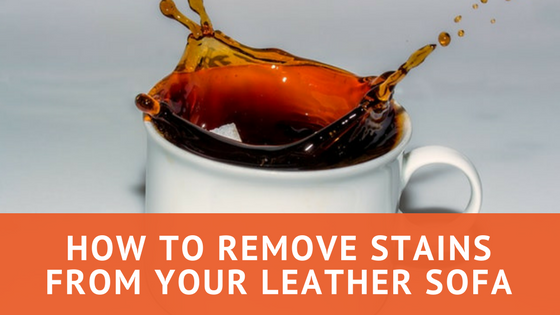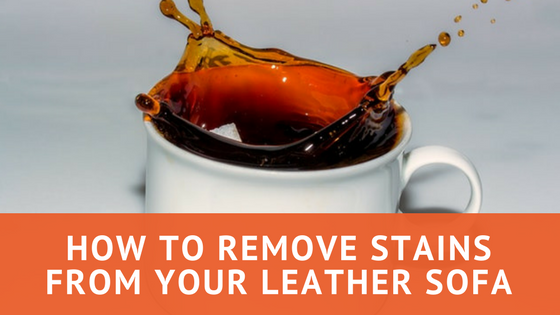
How To Remove Stains From Leather
We meet many people in search of leather sofas and sectionals as their go-to furniture upgrade choice. A big, comfortable leather sectional is the pièce de résistance of the furniture world, so it’s no wonder its one of the more popular pieces.
We’re often impressed with the level of knowledge and research our customers come equipped with, regarding leather’s durability, quality, pricing, and practicality. What many customers don’t possess, is an in-depth knowledge of what it takes to maintenance and care for leather; most stop with the recommended application of leather protectant. When a spill or a stain happens, many people believe that the only answer is to reupholster the problem area, or permanently cover it up with a nice throw-pillow or blanket, masking the stain.
Both bonded and genuine leather sofas are durable and resistant to stains, but accidents can happen. If left untreated, you’ll be staring at a juicy stain blotch every time you enter the room. Of course, we know a trick or two.
In this post, we’ll outline and explain some of our favourite ways to remove stains from your leather sofa or sectional so you can enjoy your investment for years to come.
In this video, we will show you how to remove some of the most common stains.
Ink Stains
Ink is particularly difficult to remove from leather, and a good culprit of stains. This can easily happen to your sofa if you have young creative children who use the living room as a painting studio, or if you’ve mistakenly left a faulty pen in your pant pocket as you watch a movie after dinner. In any event, ink can be treated and removed from leather.
Spray the affected area with hairspray to help extract the ink from the leather surface. Allow the hairspray to sit for about one minute, without allowing it to dry. Then, wipe the hair spray and ink away with a clean, damp cloth. After you’ve removed the hairspray, apply a small amount of moisturizing soap and clean water to the area.
An eraser can be of use to a fresh ink stain ordeal as well. Rub the eraser on the affected area to give the leather new life. However, if you’re purchasing good quality leather furniture, make sure to equip yourself with a reputable leather cleaner that’s designed to remove ink - it’s always going to be the safest and most effective way of dealing with ink stains aside from hiring a professional cleaner.
Gum
A delicious treat, but not so much so on your leather furniture. Gum is known for its ability to stick to, and strip leather of its suppleness and hue. To combat the effects of gum, there are a few trusted ways to help maintain the look of your leather furniture without having to go too wild on treatment products.
Take a bag of ice and apply it to the gum, essentially hardening and holding it in place, eliminating any potential for it to spread or worsen. Chip away the hardened gum with your fingernail and dry the area with a clean towel. Take some saddle soap or generic leather protectant and apply it to the affected area to get rid of any remnants of the gum. A toothbrush can make short work of any stubborn, hard bits. Wipe away the saddle soap and use a leather conditioner to treat the spot after all has dried.
Water-based Stains
For products and stain-makers like acrylic paints, fruit juices, grease, wine, or any other water-based stain, the best way to combat a lasting blotch is to allow the leather to dry naturally. Seems counter-intuitive, but this will help to settle the stain before you act on removing it. Keep the leather away from all sources of heat so the leather can better resist the stain, and tackle the stain with some leather soap, clean water and a clean cloth.
For grease, use talcum powder or baking soda on the stain and allow it to sit and work its magic for at least 4 hours before wiping it clean. Don’t rub the baking soda into the leather, simply let it sit. Olive oil has long been used as a good way to limit the spread of paint on leather sofas as well. Dab some olive oil on a clean cloth and dab on the stain. When/if it lifts, remove the paint with a clean rag.
When you’ve given the leather a good scrub, allow it to dry naturally again, before applying a liberal coat of leather conditioner and/or protectant.
Mildew Stains
Mildew occurs when leather is left open and susceptible to damp or wet conditions, essentially rotting the leather. There are many ways to clean mold and mildew stains from leather, but like all stains - time is of the essence.
Petroleum jelly, or vaseline is a viable stain removal choice on leather and nubuck. First, put a small layer of the jelly on a location that won’t be noticeable to test its effect before going for the stain, because it can change the colour of the leather. Run the jelly in a circular motion, helping to lift and remove the mildew stain. Allow the petroleum jelly to dry completely, and use a suede brush to help restore the texture of the material. Wipe away any excess with a clean rag.
You can also apply a mix of equal parts rubbing alcohol and water to a strong mildew stain. This method should be used only after you’ve attempted the petroleum jelly method. Again, this should be tested on a small portion of the mold stain to ensure that the colour of the leather isn’t changed.
Good old fashioned soap and water, and vinegar are good choices for mildew as well. Scrape away any mildew chunks with a brush that won’t damage the surface of the leather and lift away what you can. With any water based solution, it’s key to not allow the leather to get too wet. Alternatively, apply an equal parts water and vinegar mix to help lift the mildew stain from the leather, making sure not to oversaturate.

